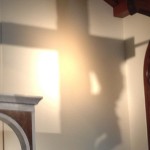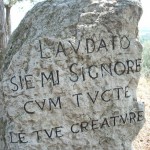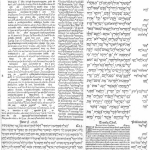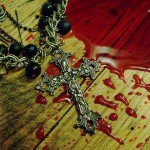Not a few American Catholic fans of Downton Abbey were taken aback by a couple of scenes in last night’s episode from Season 3. [Spoiler warning, if you’re a DA follower who’s behind on your dvr.] When Lady Sybil’s widower—the Irishman Tom Branson, who was also once the family chauffeur—announces his intentions to have their newborn daughter baptized a Catholic, he triggers an explosion of protest from Lord Grantham. “A left-FOOTER?” Robert blurts at the breakfast table.
In later scenes, the downstairs staff weigh in on the religious (and more importantly, the social) drawbacks of letting Catholicism into the household. And at an uncomfortable dinner, to which the Dowager Duchess, the Anglican vicar, and even the wayward-woman sheltering Isobel Crawley, who hasn’t even had time to change, for God’s sake, have been invited in an effort to persuade Tom of the error of his ways, the vicar spews a whole line of anti-Catholic rhetoric that sounds as though it could come from the combox of today’s LA Times.
If you don’t know the history of the Church in England, this could be some mighty surprising and perplexing stuff. Anyone who imagines that anti-Catholic sentiment in England died out soon after Bonnie Prince Charlie’s last sad stand is mistaken. And it’s never been truly about doctrine, as Thomas pointed out in last night’s episode by challenging Albert on his notion of Transubstantiation. As with most things about Downton and the society it so faithfully represents, attitudes toward Catholicism are all about class, with a side order of politics.
Lord Grantham’s casual anti-Catholicism was not uncommon for his times, although it was much more outspoken among the middle classes. By the Edwardian era, England’s Catholic nobility—a tiny, often impoverished minority since the Reformation, suffering from laws that prohibited land ownership, public worship, Catholic education, and involvement in politics or the law, to some degree or another, until the late 19th century—had begun to recover some respect. The Dowager Duchess even noted last night (in a kind of “but some of my best friends are . . .” noblesse oblige) her social approval of the Dowager Duchess of Norfolk, head of one of England’s most prominent Catholic families.
But since the famines of the 1800s sent thousands of poor Irish to England in search of work, Catholicism had for the most part been associated with the lower classes, the ignorant, the superstitious, and worst of all, those with bad taste. “Don’t let Cora do the flowers,” the Dowager Duchess cautioned Lord Grantham during a Season 2 episode. “She always makes it look like an Italian First Communion.” Irish Catholicism also bore (and continued to bear into our own times) the taint of rebellion and terrorism, as Irish Republicans sought to throw off the rule of Protestant Britain. Poor Tom Branson offends on both counts; he’s of the working class, and he’s a Republican activist.
When Lord Grantham pales at having a left-footer in the family, he’s using an anti-Catholic British epithet rooted in the Irish economy. By late Victorian times, factories in Ireland’s Protestant north were turning out steel spades for digging, with metal footrests on either side of the shaft for digging with either foot. Catholics in the south retained their old narrow spades, with a footrest carved out of one side of the wooden shaft. They “dug with the wrong foot,” and even though it was most often the right foot, the association of the left side with all things sinister (the Latin for left) quickly turned “wrong” to “left.”
Lord Grantham’s sneering reference to Tom’s “tribe” reflects another tendency among the Protestant British to equate Catholics with Jews in their “otherness.” Over the centuries, both Jews and Catholics have suffered persecution in England. Jews were expelled from the country in 1290 by King Edward I, and though his Edict of Expulsion was overturned by Oliver Cromwell in the 1600s, Jews were not permitted to serve in Parliament until the 19th century. Catholics endured virtual expulsion, under laws that suppressed the practice of the faith. And though the laws have changed, attitudes have not necessarily kept up. It was just last year, for example, that Britain’s Act of Succession was amended to allow the heir to the throne to marry a Catholic.
Because I’m avoiding spoilers, I haven’t looked ahead to see what difference, if any, the younger Crawleys’ more open religious attitudes will make at Downton. But I welcomed the chance to review again the complicated history of the Church in England—a history my own family was part of. And I love the irony, in the end, of Lord Grantham’s exercising his anti-Catholic snobbery at the dining table in his beloved Downton Abbey, an estate whose name betrays that it was built on property seized from a Catholic religious order during Henry VIII’s dissolution of the monasteries.
Tread lightly, Lord Grantham. You’re living on left-foot land.












